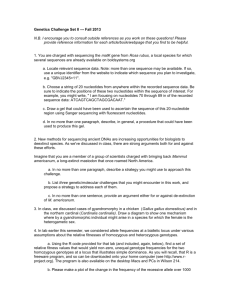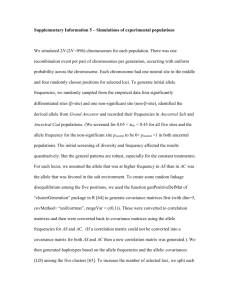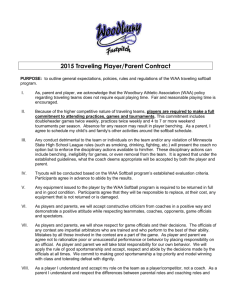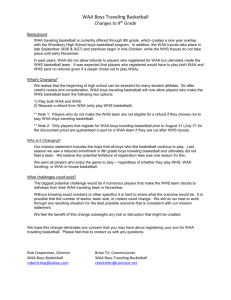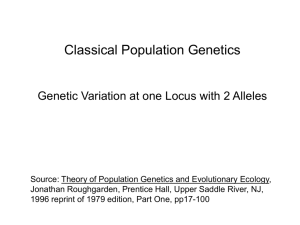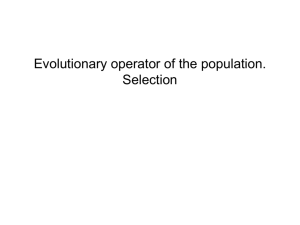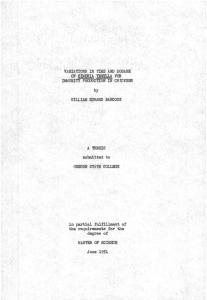FinalExam
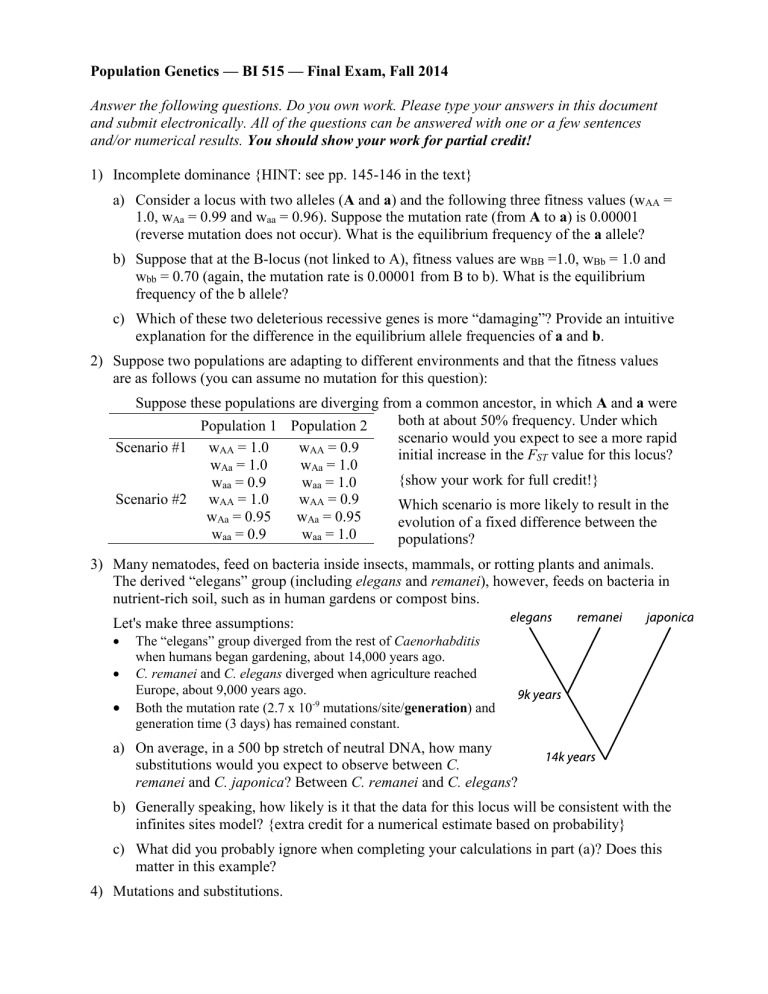
Population Genetics — BI 515 — Final Exam, Fall 2014
Answer the following questions. Do you own work. Please type your answers in this document and submit electronically. All of the questions can be answered with one or a few sentences and/or numerical results. You should show your work for partial credit!
1) Incomplete dominance {HINT: see pp. 145-146 in the text} a) Consider a locus with two alleles ( A and a ) and the following three fitness values (w
AA
=
1.0, w
Aa
= 0.99 and w aa
= 0.96). Suppose the mutation rate (from A to a ) is 0.00001
(reverse mutation does not occur). What is the equilibrium frequency of the a allele? b) Suppose that at the B-locus (not linked to A), fitness values are w
BB
=1.0, w
Bb
= 1.0 and w bb
= 0.70 (again, the mutation rate is 0.00001 from B to b). What is the equilibrium frequency of the b allele? c) Which of these two deleterious recessive genes is more “damaging”? Provide an intuitive explanation for the difference in the equilibrium allele frequencies of a and b .
2) Suppose two populations are adapting to different environments and that the fitness values are as follows (you can assume no mutation for this question):
Suppose these populations are diverging from a common ancestor, in which A and a were
Population 1 Population 2 both at about 50% frequency. Under which scenario would you expect to see a more rapid
Scenario #1
Scenario #2 w w
AA
AA
= 1.0 w
Aa
= 1.0 w aa
= 0.9
= 1.0 w
AA
= 0.9 w
Aa
= 1.0 w w aa
AA
= 1.0
= 0.9 w
Aa
= 0.95 initial increase in the F
ST
value for this locus?
{show your work for full credit!}
Which scenario is more likely to result in the w
Aa
= 0.95 w aa
= 1.0 evolution of a fixed difference between the w aa
= 0.9 populations?
3) Many nematodes, feed on bacteria inside insects, mammals, or rotting plants and animals.
The derived “elegans” group (including elegans and remanei ), however, feeds on bacteria in nutrient-rich soil, such as in human gardens or compost bins.
Let's make three assumptions:
The “elegans” group diverged from the rest of Caenorhabditis when humans began gardening, about 14,000 years ago.
C. remanei and C. elegans diverged when agriculture reached
Europe, about 9,000 years ago.
Both the mutation rate (2.7 x 10 -9 mutations/site/ generation ) and generation time (3 days) has remained constant.
a) On average, in a 500 bp stretch of neutral DNA, how many substitutions would you expect to observe between C. remanei and C. japonica ? Between C. remanei and C. elegans ? b) Generally speaking, how likely is it that the data for this locus will be consistent with the infinites sites model? {extra credit for a numerical estimate based on probability} c) What did you probably ignore when completing your calculations in part (a)? Does this matter in this example?
4) Mutations and substitutions.
Population Genetics — BI 515 — Final Exam, Fall 2014 a) Explain the difference between the mutation rate µ and the substitution rate k . b) Does the rate of neutral DNA sequence evolution (i.e., the accumulation of substitutions over time) depend on population size? Why or why not? (Use an equation from lecture to support your answer.) c) Suppose you study two populations, A and B, both of which have historically had large population sizes. Population A goes through a small and extended bottleneck event, while population B maintains its current population size. During this period of time, which population will have a larger total number of new mutations? Which population will accumulate a larger number of substitutions and why?
5) Consider a locus at which the fitness values are w
AA
= w aa
= 1s and w
Aa
= 1, values corresponding to overdominance (= heterozygote advantage) if s is positive. Use the
DiffusionApproximation.xlsx file on the course web page to predict the expected allele frequency distribution for an overdominant locus with s = 0.01. {Assume equal forward and reverse mutation rates of 0.00001 and use the “Hamilton” equation/graph in the spreadsheet, which models heterozygote advantage.} a) Given the fitness values above, what is the expected allele frequency for a large population? b) Using the spreadsheet, compare results for populations of size N e
= 500 and N e
=
5,000. Explain what these plots illustrate and describe the difference in results for the two population sizes. Explain how population genetic processes are responsible for the difference in results. c) Now change the A to a mutation rate to 0.001. How do the results change for N e
= 500 and N e
= 5,000 and why?
6) Fate of new mutations… a) For populations of any appreciable size, what is the probability that a brand new, neutral mutation (present as a single copy in a diploid population of size N ) is lost by genetic drift in the very next generation? b) A new, nearly neutral (i.e., slightly deleterious) mutation is more likely to go to fixation in a small population. How does population size affect the probability of fixation for a new advantageous mutation (s > 0, with w
AA
= 1 + 2s, w
Aa
= 1 + s, and w aa
= 1, where A is the new allele)? {hint: see “Lecture 15” on course webpage} c) In general, what is the probability of fixation for a new advantageous mutation? d) What does this result have to say about adaptive evolution in natural populations?
7) F
ST a) Term-by-term, explain the logic of this equation for the fixation index in a population
Population Genetics — BI 515 — Final Exam, Fall 2014 that receives immigrants at rate m from another population(s).
F t
= ç
1
2 N
ö
ø
(
1
m
) 2 +
æ
1
-
1
2 N
ö
ø
(
1
m
) 2
F t
-
1 b) Setting F t
= F t-1
(i.e., the expected value of F at equilibrium), rearranging and ignoring terms with m 2 , the above equation can be rearranged to: .
Using a plot of F versus Nm , explain the significance of Nm = 1 as a classic threshold in population genetics.
8) Joint Allele Frequency Spectrum a) Explain as clearly as possible what the figures to the right illustrate (e.g., what are the x- and y-axes and what does the color scale mean? What kind of data is used to generate this figure?) b) Is the average F
ST
value higher in the upper figure or the lower figure? c) Propose reasonable scenarios (i.e., differences in population history) that could account for the different patterns in the upper and lower figures, respectively.
9) Outline the basic logic of a genome scan in which two populations are compared to find loci that are outliers from the overall pattern of genomic diversity and divergence. What conditions must be met for this approach to allow specific loci involved in adaptive divergence between populations to be identified?
